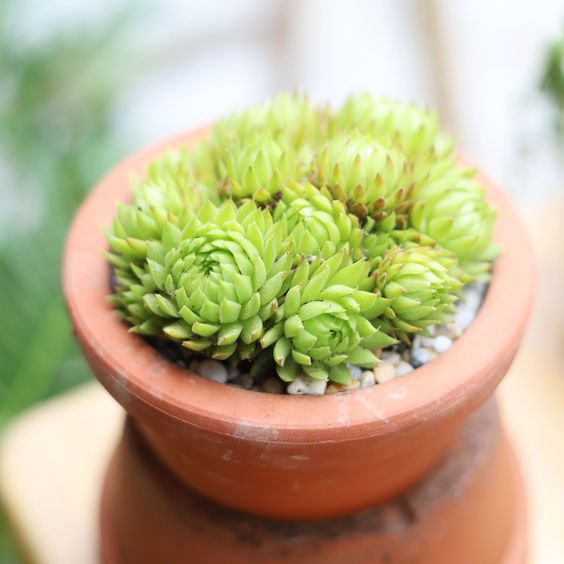More commonly known as “Hens and Chicks” or the Houseleek, Sempervivum succulents are best known for their tight rosettes and ability to reproduce via offshoots. With over 40 unique species in various colors, shapes, and sizes, these hardy succulents can thrive almost anywhere, in any weather. As an indoor plant, they make for excellent compact ornaments, and in the garden, the Sempervivum’s ability to quickly produce offshoots makes it an excellent groundcover.
General Care
As a fantastic starter succulent, the Sempervivum genus is incredibly hardy and can handle a wide range of light levels, water levels, and temperatures. For more specific information regarding the care of your Sempervivum, check out our individualized guides for each plant!
1. Light
Bright, indirect light is the secret to a happy succulent, and although the Sempervivum will tolerate partial shade, it cannot handle direct light. Since succulents store water in their leaves, direct sun (especially in the afternoon) will quickly burn these plants and damage their leaves. To avoid a sunburnt Sempervivum, we recommend keeping it near an east or south-facing window, where it will receive indirect light throughout the day. Turn your succulent every so often, so it receives even amounts of sunlight. Outdoors, give your Hens and Chicks a shaded reprieve during the afternoons.

2. Soil
Like all succulents, well-draining soil is a must for a Sempervivum. The best way to achieve good drainage is to use a cactus potting mix or to modify a traditional potting mixture using perlite, coarse sand, and peat moss.
3. Water
You’ll only need to water your Sempervivum once every two weeks or so when its soil is completely dry to the touch. If you live in a warmer climate, you may need to water your Sempervivum more often. Regardless of the watering schedule, always let any excess liquid drain from the pot before putting your succulent away. Additionally, use the bottom-watering method or a watering bottle to avoid getting water on your Sempervivum’s leaves.
4. Temperature and Humidity
As we’d mentioned earlier, members of the Sempervivum genus can tolerate a wide range of temperatures, from 45 degrees Fahrenheit to 80 degrees Fahrenheit, in USDA Agricultural zones 3-8. However, it’s best to keep this succulent relatively warm at around 60-80 degrees for it to thrive.
As for humidity, try to keep your home around a low 40% to prevent mold growth on your leaves.
5. Fertilizer
Sempervivum succulents do not require fertilizer to thrive, but if you’d like to give your succulent a little nutrient boost, add some compost to your soil mix when you repot your succulent.

Potting and Repotting
When you repot your Sempervivum, always do so during the growing season. For most members of the Sempervivum family, the growing season occurs in the Summer, but growing periods may vary based on the exact species. Repot once every one or two years, in a pot at least 10% larger than its previous pot.
When you choose a pot for your succulents, prioritize drainage. Selecting a pot with drainage holes will allow for water to quickly drain from your pot after watering. To further improve drainage, consider selecting a pot made from porous materials like concrete, terracotta, or ceramic.

Blooming
Sempervivum succulents are monocarpic plants, meaning they flower before they die. Fortunately, a flowering mother Sempervivum will become effective plant food for its surrounding offshoots, filling the space where the mother plant once was. If you see pink, yellow, or white flowers sprouting on long stamens from the center of your mother plant, don’t panic– you might as well enjoy them as the new generation of chicks take over.
Pruning and Propagation
Typically, you won’t need to prune a Sempervivum. Even if the succulent becomes leggy or starts to grow unevenly, simply turn the pot to have a different section of leaves facing the sun. However, you may need to prune offshoots from your Sempervivum to propagate them or keep the pot from becoming overfilled.
To collect an offshoot, wait for it to begin taking root. Then, cut it off from the mother plant using a clean, sharp pair of scissors or a knife. Move the offshoot to its own little pot for propagation.
Dormancy
Sempervivum succulents go dormant in the winter when temperatures drop below 40 degrees Fahrenheit. During this time, your Sempervivum may appear dead or wilted, but it’s still very much alive– it’s simply conserving energy to grow during the spring. While your Sempervivum is dormant, it won’t need as much water or sunlight as usual. When you water your dormant Sempervivum, give it about half as much water as you would during the growing season. If your Hens and Chicks are outside, prepare them for the winter with a layer of straw to insulate them. While these succulents are frost-hardy, they can only tolerate so much cold!

Common Pests and Complications
The biggest complication you’ll face with Sempervivums is overwatering. Poor soil drainage coupled with an enthusiasm to care for the succulent may lead to complications from waterlogged soil. Unlike most houseplants, Sempervivum succulents are very hands-off. Overwatering can eventually lead to root rot, mold, and fungal infections, or the appearance of fungal gnats. Outdoors, watch for common garden pests like aphids or spider mites.
Toxicity
Sempervivum succulents aren’t toxic to animals or people, but it’s still best to keep them out of reach from curious animals or children.
See more about How to Care for Sedum Golden Moss
And get a free plant when your friends make an order. Sign up here!
Learn more about how to nurture and enjoy many gorgeous succulents and clever decoration tips with our newsletter. Let's sign up!































